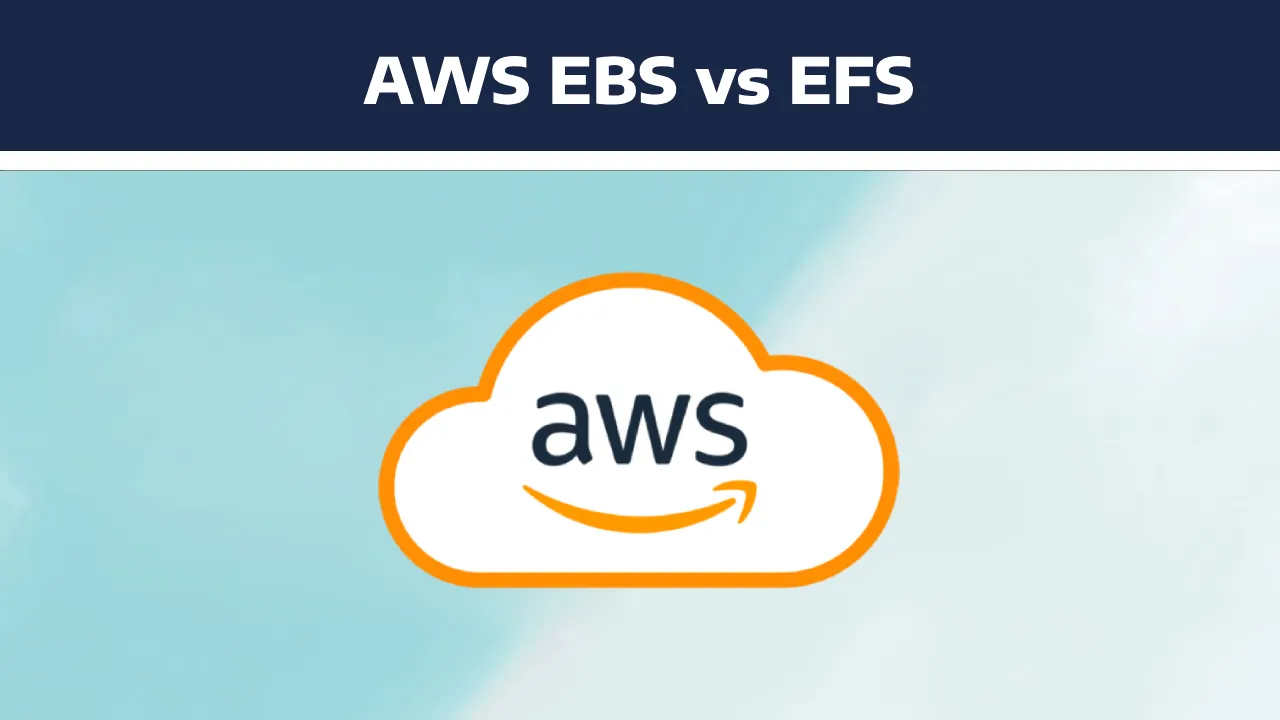Comprehensive Comparison: AWS EBS vs. EFS
Amazon Web Services (AWS) offers a variety of storage services to cater to the diverse needs of cloud users. Two prominent options for storing data are Amazon Elastic Block Store (EBS) and Amazon Elastic File System (EFS). In this comprehensive comparison, we'll delve into the details of EBS and EFS, exploring their features, use cases, performance characteristics, and considerations to help users make informed decisions about selecting the right storage solution for their AWS workloads.
1. Introduction to EBS and EFS
1.1 Amazon Elastic Block Store (EBS)
Definition: Amazon EBS provides block-level storage volumes for use with Amazon EC2 instances. EBS volumes are highly available and durable, offering persistent storage that can be attached to EC2 instances for data storage.
Key Features:
- Block-level storage
- Persistent and durable
- Variety of volume types (gp3, io2, st1, sc1, standard)
- Snapshot backups
- Single EC2 instance attachment
1.2 Amazon Elastic File System (EFS)
Definition: Amazon EFS is a fully managed, scalable file storage service designed to be shared across multiple EC2 instances. It uses the Network File System version 4 (NFSv4) protocol, allowing multiple instances to concurrently access the same data.
Key Features:
- File-level storage
- Scalable and shared across instances
- Supports NFSv4 protocol
- Automatic scaling
- Regional storage
2. Use Cases: When to Use EBS or EFS
2.1 Amazon EBS Use Cases
2.1.1 Databases:
- EBS is well-suited for hosting databases that require high-performance, low-latency storage.
2.1.2 Boot Volumes:
- EBS volumes can be used as boot volumes for EC2 instances, providing a durable and persistent storage solution.
2.1.3 Transactional Workloads:
- Applications with transactional workloads, such as online transaction processing (OLTP) systems, benefit from the low-latency and high-IOPS capabilities of EBS.
2.2 Amazon EFS Use Cases
2.2.1 Content Management Systems (CMS):
- EFS is ideal for CMS applications where multiple instances need access to shared content, such as images and templates.
2.2.2 Development and Testing:
- For development and testing environments requiring shared file storage among multiple instances, EFS simplifies collaboration.
2.2.3 Big Data and Analytics:
- EFS can be used for storing and sharing data sets in big data and analytics applications that involve multiple instances working concurrently.
3. Performance Characteristics
3.1 Amazon EBS Performance
3.1.1 Volume Types:
- EBS offers different volume types, including gp3 for general-purpose SSD, io2 for provisioned IOPS, st1 for throughput-optimized HDD, sc1 for cold HDD, and standard (magnetic).
3.1.2 IOPS and Throughput:
- Performance characteristics depend on the selected EBS volume type, with options to configure IOPS (input/output operations per second) and throughput based on workload requirements.
3.2 Amazon EFS Performance
3.2.1 Throughput Modes:
- EFS provides two throughput modes: Bursting and Provisioned. Bursting offers burst credits for occasional high throughput, while Provisioned allows users to configure consistent throughput.
3.2.2 Scaling:
- EFS scales automatically as data grows, ensuring that performance scales with the storage size.
4. Storage Classes and Durability
4.1 Amazon EBS Storage Classes
4.1.1 Standard:
- General-purpose SSD storage with balanced performance.
4.1.2 Infrequent Access (IA):
- Cost-effective storage for infrequently accessed data.
4.1.3 Throughput Optimized:
- HDD storage optimized for throughput-intensive workloads.
4.1.4 Cold HDD:
- Low-cost storage for infrequently accessed data with lower throughput requirements.
4.2 Amazon EFS Storage Durability
- EFS provides high durability by automatically replicating data across multiple Availability Zones within a region.
5. Snapshot and Backup Capabilities
5.1 Amazon EBS Snapshots
- EBS volumes support snapshots, allowing users to create point-in-time backups of volumes. Snapshots are incremental and are stored in Amazon S3.
5.2 Amazon EFS Backup
- EFS does not provide a built-in snapshot mechanism like EBS. However, users can implement backup strategies by creating copies of data or using third-party tools.
6. Cost Considerations
6.1 Amazon EBS Pricing
- EBS pricing is based on the provisioned storage capacity and the chosen volume type. Additional costs may apply for IOPS and data transfer.
6.2 Amazon EFS Pricing
- EFS pricing is based on the amount of storage used and any additional data transfer costs. There are no upfront fees or commitments.
7. Availability and Redundancy
7.1 Amazon EBS Availability
- EBS volumes are specific to a single Availability Zone. Users can configure data replication using EBS Multi-Attach for shared access across multiple instances.
7.2 Amazon EFS Availability
- EFS is designed for high availability and automatically replicates data across multiple Availability Zones within a region, ensuring redundancy and availability.
8. Security and Access Control
8.1 Amazon EBS Security
- EBS volumes are typically attached to a single EC2 instance, and access control is managed through IAM roles, security groups, and network ACLs.
8.2 Amazon EFS Security
- EFS uses standard AWS security mechanisms, including IAM roles and security groups, to control access. Network ACLs and encryption options enhance security.
9. Integration with AWS Services
9.1 Amazon EBS Integration
- EBS integrates seamlessly with EC2 instances and is commonly used for block storage requirements of various applications.
9.2 Amazon EFS Integration
- EFS integrates with various AWS services, including EC2 instances, ECS, EKS, and Lambda, providing shared storage for diverse workloads.
10. Conclusion: Choosing Between EBS and EFS
The choice between Amazon EBS and EFS depends on the specific requirements of your workload. Use EBS for applications that demand block-level storage, high-performance I/O, and low-latency access, such as databases and boot volumes. On the other hand, choose EFS for scenarios that require shared file storage across multiple instances, like content management systems, development environments, and analytics workloads.
In summary, both EBS and EFS are versatile and powerful storage solutions within the AWS ecosystem, each catering to different use cases. By understanding the features, performance characteristics, and pricing models of EBS and EFS, users can make informed decisions to optimize storage for their AWS workloads.
